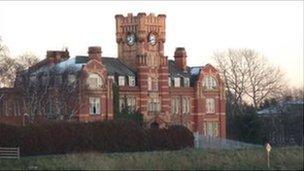10% of Wales' listed buildings may be lost, says expert
- Published

A shocking number of listed buildings in Wales is at risk of being lost, a heritage expert has warned.
Of Wales' 30,000 listed buildings, about 10% are on local authority "at risk" registers, which are compiled with the help of heritage body Cadw.
Architectural historian Mark Baker told BBC Radio Wales' Eye on Wales programme: "It's a shocking scenario."
Councils have powers to protect the buildings but Mr Baker said not all were keen to do so.
Under listed building legislation, local authorities can intervene through enforcement action, repairs notices, compulsory purchase and other measures.
Mr Baker, an architectural historian who has published books about Welsh country houses, said: "On a national level, I think it is quite shocking for such a small country to have such a large amount of historic buildings at risk - at least 10% of its overall total, in theory at risk of being lost overnight.
"It's a shocking scenario."
Mr Baker claims some local authorities are proactive in taking action over buildings at risk, but others are less keen to get involved in safeguarding historic buildings.
A report published earlier this year by campaign group Save Britain's Heritage featured nine historic Welsh buildings at risk.
Among them was Plas Gwynfryn, a 19th Century ruined country house at Llanystumdwy, near Criccieth, Gwynedd, which was once the home of Conservative MP Ellis Nanney.
Aaron Hill, who lives near Caernarfon, wants to take over and renovate the property, which was gutted by fire in 1982.
However, attempts by Gwynedd council to trace the owner have failed.
Mr Hill told Eye on Wales: "I would like to save it from ruin.
"At the moment it's just been left, no maintenance has taken place and it is in danger."
Gwynedd council said it had investigated the case and "based on the evidence relating to the condition of the building, it was not considered expedient to take formal enforcement action".
'Balanced view'
It said anyone interested in buying the building should "pursue the matter directly with the owner".
The Welsh Local Government Association (WLGA) said the number of at-risk buildings was decreasing slowly, and council conservation officers had worked with Cadw to develop registers of such buildings.
Peter Gomer, of the WLGA, said: "Local authorities have to have a balanced view in terms of what they can do.
"Each [building] has to be looked at on its own merits - what is a sustainable way forward, how do we select which one is to be done?
"It's got to be done on the basis of sustainability. Sticking plasters are no good, because we can continue putting sticking plasters on and eventually it will fall down."
Eye on Wales is on BBC Radio Wales at 13:04 BST on Sunday, 16 October.
- Published1 June 2011